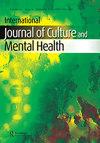伊朗德黑兰大学生非自杀性自伤:患病率、特征和危险因素
Q1 Social Sciences
International Journal of Culture and Mental Health
Pub Date : 2017-04-03
DOI:10.1080/17542863.2016.1265999
引用次数: 18
摘要
尽管西方国家对非自杀性自伤(NSSI)的实证和临床关注有所增加,但非西方文化对自伤的了解却少得多。本研究首次调查了伊朗德黑兰大学生自伤的患病率、特征和危险因素。所有参与者(n = 554,平均年龄= 22.65,其中57.2%为女性)被要求在其一生中自我报告自伤。采用《情绪调节困难量表》、《抑郁、焦虑、压力量表》和《自杀行为问卷-修订版》。终生自伤患病率为12.3% (n = 68),无性别差异。经logistic回归分析,在控制焦虑、抑郁和自杀倾向后,女性的情绪意识缺失仍呈显著负相关;然而,在控制心理症状后,男学生的情绪失调与终生自伤史之间没有关系。在一个单独的逻辑回归中,终生自伤预测自杀企图高于抑郁症状和自杀意念的性别。我们关于情绪失调与终生自伤之间关系的研究结果与西方的大量研究相矛盾,强调情绪失调是自伤的一个危险因素,并表明这种关系可能因文化而异。结果被置于社会文化背景下,并与西方数据进行比较和对比。本文章由计算机程序翻译,如有差异,请以英文原文为准。
Non-suicidal self-injury in a sample of university students in Tehran, Iran: prevalence, characteristics and risk factors
ABSTRACT Despite increased empirical and clinical attention to non-suicidal self-injury (NSSI) in Western countries, far less is known about NSSI in non-Western cultures. This study is the first to investigate the prevalence, characteristics and risk factors of NSSI in a sample of university students in Tehran, Iran. All participants (n = 554, mean age = 22.65, 57.2% female) were asked to self-report on NSSI over their lifetime. The Difficulties in Emotion Regulation Scale, Depression Anxiety Stress Scales, and Suicidal Behaviors Questionnaire-Revised were employed. A lifetime NSSI prevalence of 12.3% (n = 68) was found with no gender differences. Using logistic regression, lack of emotional awareness remained negatively significant for females after controling for anxiety, depression and suicidality; however, after controlling for the psychological symptoms, no relations were found between emotion dysregulation and a history of lifetime NSSI for male students. In a separate logistic regression, lifetime NSSI predicted suicide attempt above and beyond depressive symptoms and suicidal ideation across gender. Our results on the relations between emotion dysregulation and lifetime NSSI contradict the ample research in the West, emphasizing emotion dysregulation as a risk factor of NSSI and suggest that this relation might vary across cultures. The results are situated within the sociocultural context and compared and contrasted with Western data.
求助全文
通过发布文献求助,成功后即可免费获取论文全文。
去求助
来源期刊

International Journal of Culture and Mental Health
Social Sciences-Cultural Studies
CiteScore
2.10
自引率
0.00%
发文量
0
期刊介绍:
This title has ceased (2018). This important peer-review journal provides an innovative forum, both international and multidisciplinary, for addressing cross-cultural issues and mental health. Culture as it comes to bear on mental health is a rapidly expanding area of inquiry and research within psychiatry and psychology, and other related fields such as social work, with important implications for practice in the global context. The journal is an essential resource for health care professionals working in the field of cross-cultural mental health.Readership includes psychiatrists, psychologists, medical anthropologists, medical sociologists, psychiatric nurses and social workers, general practitioners and other mental health professionals interested in the area. The International Journal of Culture and Mental Health publishes original empirical research, review papers and theoretical articles in the fields of cross-cultural psychiatry and psychology. Contributions from the fields of medical anthropology and medical sociology are particularly welcome. A continuing dialogue between members of various disciplines in various fields is encouraged. The aim of the journal is to encourage its readers to think about various issues which have clouded cross-cultural development of ideas. The journal lays special emphasis on developing further links between medical anthropology, medical sociology, clinical psychiatry and psychology, and implications of the findings on service provisions. The journal is published four times a year. The style of reference is Harvard. All research articles in this journal, including those in special issues, special sections or supplements, have undergone rigorous peer review, based on initial editor screening and anonymized refereeing by at least two independent referees.
 求助内容:
求助内容: 应助结果提醒方式:
应助结果提醒方式:


